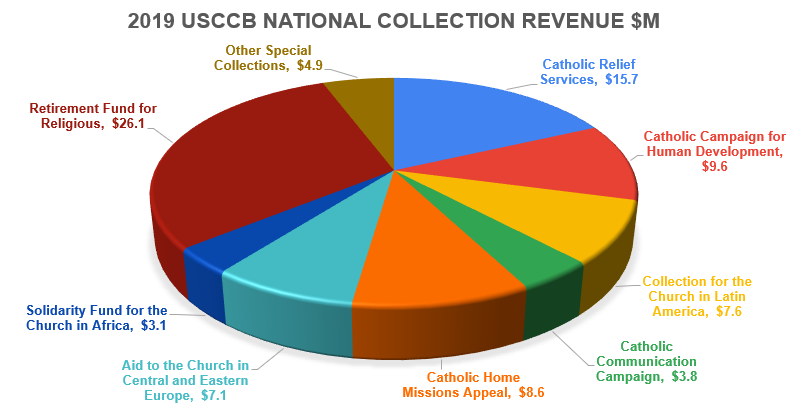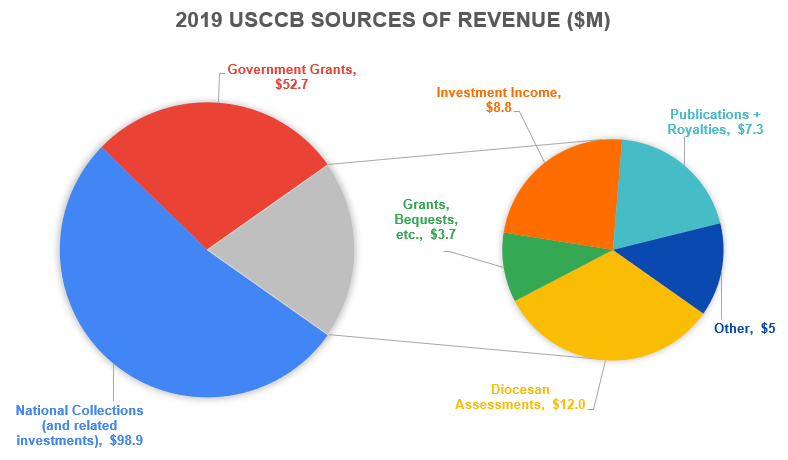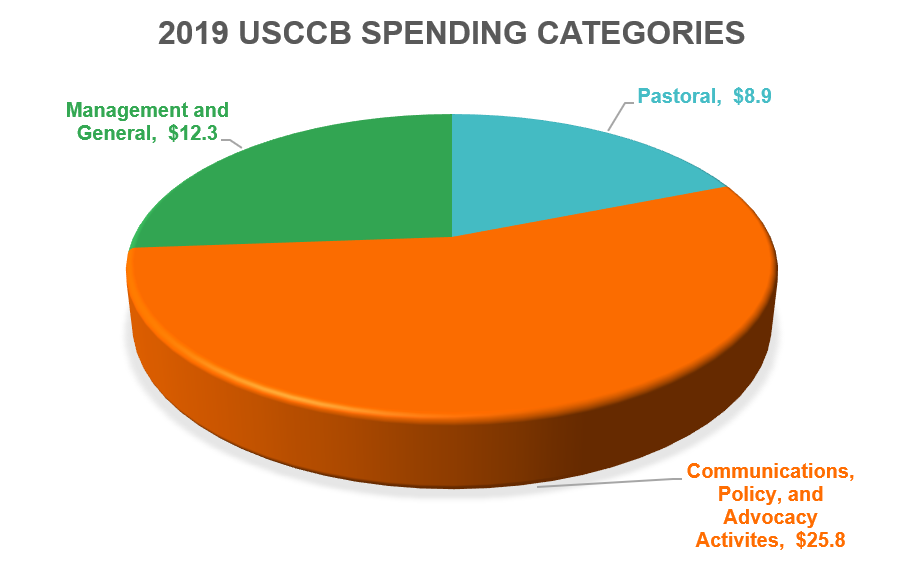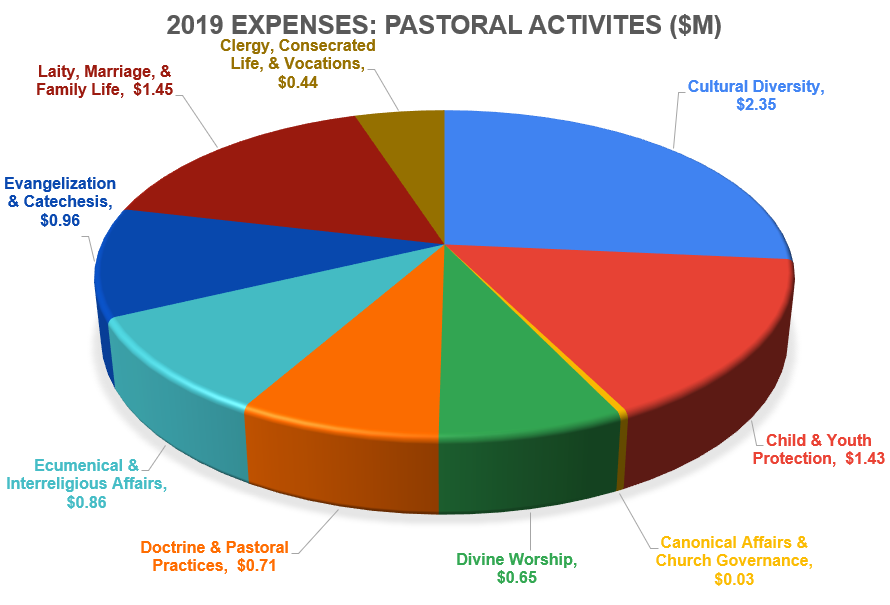
The U.S. Conference of Catholic Bishops is the most visible institution of Catholic hierarchy in the United States, but also one of the least understood. While many Catholics have some sense of how their local pastor or diocesan bishop spends his time, far fewer have a clear idea of what actually happens at the USCCB.

As a prominent institution, but one without the opportunity for the personal relationships of diocesan bishops or parish pastors, the USCCB invites more criticism than praise, and the conference faces that criticism from across the ideological spectrum.
Among the most frequent topics of critique is money: Commentators often suggest the USCCB has too much money, is spending it on the wrong things, or gets it from the wrong places.
The conference’s finances are complex, and understanding them clearly takes a little bit of work. So to help Catholics weigh what they hear about the USCCB’s money — and decide whether the critics are fair — The Pillar offers a look at the cash of the conference.
What is the financial structure of the USCCB? Where does the money come from and what does it do? We’ve got some answers.
Cash in context
The USCCB’s 2019 financial reports (the most recent year of audited financials available) shows net assets of $377 million and total revenues of $188 million.
Numbers like that can be difficult to understand without context, especially for Catholics more accustomed to dealing with money in the parish checking account or a family 401k.
One way to put the USCCB numbers into context is by comparison with the business world. For that, the “Fortune 1,000” list of America’s largest businesses is a good place to start.
In 1,000th place on the 2021 “Fortune 1,000” list is Clear Channel Outdoor Holdings, which provides billboard advertising. Clear Channel has annual revenues of $1.85 billion — about 10 times the amount of the USCCB’s revenue, and assets of $5.75 billion — 15 times the USCCB’s assets.
The Clear Channel comparison offers one way to see the USCCB’s financial position: The conference has one-tenth the revenue and one-fifteenth the assets of the smallest Fortune 1,000 company in America.
Another way to understand the USCCB’s financial position is to see it in the context of other non-profits.
The NonProfit Times — the “leading business publication for non-profit management” keeps a list of the country’s 100 largest non-profits. On the 2019 list, the largest non-profit was the YMCA, with over $7 billion in annual revenue.
The USCCB is too small to make the list. The bishops’ conference is beaten out by the Museum of Modern Art (#75 with $279M in annual revenue), the Wounded Warrior Project (#84, $264M), Ducks Unlimited (#97, $212M), and the American Museum of Natural History (#100, $205M).
There are other Catholic non-profits on the list, though. The largest is Catholic Charities USA (#3, $4.365 billion), but also on the list is the Catholic Medical Mission Board, a global NGO based in New York, and Cross Catholic Outreach, a Florida-based aid organization.
While those groups have considerably more money than the bishops’ conference, the USCCB’s $188 million in annual revenue is still a lot of cash.
A church comparison may be the most helpful: A large American suburban parish often sees collections between $1 and $2 million annually, and only the largest few dioceses have more annual revenues than the USCCB.
Revenue streams
So where does the USCCB’s money come from? And how is it being spent?
To understand that, it may help to think of the bishops’ conference as three connected organizations, rather than one, because its revenues come from three very different sources, each committed and designated for different purposes.
National collections
The most USCCB revenue comes from national collections, taken up in parishes at different times throughout the year and are managed by the bishops’ conference. These include the Retirement Fund for Religious, the Catholic Services Appeal, and the Catholic Campaign for Human Development, as well as other annual collections or special collections to provide relief in the wake of specific disasters.
The proceeds of those collections are known as “restricted funds,” meaning that the USCCB is legally and morally obliged to spend the money only on the specific programs to which donors have contributed. These funds cannot be used for more general USCCB activities. If not all the funds raised are spent within a given year, they are saved for future needs, and the USCCB tracks both the assets of those programs and the investment income from investing those assets, making sure the money is spent for its designated purpose.
In 2019, the USCCB received $86.5M in revenue from national collections, and recorded an additional $12.4M in investment income to national collections accounts.
The USCCB is not the final destination for national collection funds. The conference does provide some administrative services for the collections, and keeps a portion of money for those costs. But 94% of the money is passed on to organizations which provide the final services — often through grants.
While the USCCB does manage these funds and they are accounted as revenue, the funds themselves are not available to be spent at the bishops’ discretion — unless departments of the bishops’ conference actually apply for and receive collections grants, as the Secretariat of Cultural Diversity did in 2020.
Government grants
Another significant portion of USCCB revenue comes from government grants.
In 2019 those grants totalled $52.7M in revenue. The money comes from government programs providing services to refugees and migrants under the Department of Health and Human Services and the State Department, and the grants, like national collections, are restricted funds.
The USCCB is responsible to the U.S. government to show that the funds are directed to the intended services, and any money not spent on their designated activities must be refunded.
The largest piece of government funding the USCCB received in 2019 came from a set of grants totaling $23M as part of the Unaccompanied Alien Children Program (UAC). This represented 1% of the $1.8 billion which The Department of Health and Human Services spent on the UAC in 2019.
A number of the UAC program’s other grants also went to religiously affiliated institutions, according to the Tracking Accountability in Government Grants System (TAGGS). Other UAC grant recipients included BCFS Health and Human Services ($251) which has historic ties with the Baptists; Lutheran Immigration & Refugee Services ($37M); and the Board of Child Care of the United Methodist Church ($7M).
While the USCCB is the largest Catholic grant recipient, other Catholic organizations received separate grants from the UAC, including Catholic Charities of the Archdiocese of Miami ($8M).
That $23M the USCCB received from the UAC program does not represent a single grant, but instead is a collection of more than 20 grants for different services, including as “Refugee Cash and Medical Assistance” and “Residential Shelter Services for Unaccompanied Children.”
Government grant revenue received by the USCCB for programs other than the UAC is similarly structured and can be seen in the graph below.
Like the national collections, the USCCB functions primarily as an aggregator, passing on the collected funds to the local Catholic organizations that will do the actual work, but on these refugee and migrant services the bishops’ conference does a portion of the work itself.
According to its 2019 expense statements, the USCCB spent $10M on salaries, travel, professional services, etc. related to providing migrant and refugee services. It passed on an additional $45M to local Catholic sub-recipient organizations which provided additional services to fulfill the government contracts the USCCB received.
Operating income
The third and smallest category of USCCB revenue goes to operating income, used for the operational programs and offices of the bishops’ conference itself. In 2019, this consisted of $36.8M in revenue, and it came from a hodgepodge of sources.
Twelve million of that operating revenue came from diocesan assessments. Just as dioceses get some of their operating funds by applying a tax (often about 10%) on parish collections, the USCCB gets a portion of its funding from assessments, paid by each diocese to the national organization.
The USCCB assessment is relatively small compared to the diocesan assessments levied on parishes in many places. Some dioceses do not even report the USCCB assessment on their financial reports because it is such a small expense, and several of those that did include the assessment said they gave the USCCB an assessment equal to less than 1% of their diocesan revenue.
Another way to think of the $12M in diocesan assessments is that it equals $0.17 per Catholic in the United States. For a comparison, U.S. diocesan budgets range from $30 to $150 per Catholic in the diocese.
The next largest source of USCCB operating income came from investment earnings ($8.8M), followed by earnings from publications and royalties ($7.3M). The USCCB holds the copyright to the American English version of the Catechism of the Catholic Church as well as the New American Bible and other liturgical and catechetical texts. Royalties or publishing profits from these works and others provide this portion of USCCB income.
Other donations, grants, and sources of revenue made up another $8.7M in 2019.
How the operating income gets spent
The USCCB classifies its operating revenue expenditures into three major categories: Pastoral; Communications, Policy and Advocacy Activities; and Management and General.
“Management and General” is what the name implies: the basic expenses of running the bishops’ conference — things like accounting and human resources. Half the expenses in that category are the salaries of staff. Another quarter are professional and contract services. The rest are travel, meetings, and other operational expenses.
The rest of the activities conducted by the USCCB are divided into two broad category groups: “Pastoral Activities” and “Communications, Policy, and Advocacy.”
Those categories, too, are the internally conducted activities of offices and departments of the bishops’ conference. Sixty percent of the expenses are salaries of USCCB staff. The remainder consists of travel and meeting expenses, professional and contract services, and other operating expenses.
$8.9M was spent in 2019 on the activities defined as pastoral, divided into sub-categories like Cultural Diversity ($2.35M), Laity, Marriage, & Family Life, ($1.45M), Child and Youth Protection ($1.43M), Evangelization and Catechesis ($0.96M), and others — representing actual offices and departments of the bishops’ conference.
Another $25.8M was spent by the bishops’ conference on activities related to communication, policy, and advocacy. $5.1M of this went to the Catholic News Service, which provides a newswire style service managed by the USCCB. Another $5.9M went to Development & World Peace initiatives, $4.9M to Migration & Refugee Services which were not part of the government grant program. $2.4M to Pro-Life Activities. Other funds were directed to marketing resources, Catholic education, and other communications and policy programs.
The future
Is the U.S. bishops’ conference spending too much money? Or is it spending money on the right things? That’s the for the reader to decide.
But the conference has faced ongoing financial challenges in recent years, requiring bishops to approve an assessment rate hike in early 2020, and to predict narrow budget surpluses in future years. The pandemic may have actually provided some short-term cash savings to the USCCB, but its long-term effect on conference revenues is not yet clear.
With the entire Church facing ongoing revenue challenges, critics will likely continue to raise questions about the USCCB’s budget. To assess their arguments, understanding where the money actually comes from — and where it actually goes — is an important first step.









